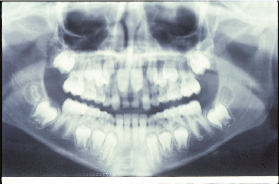Adult Braces Treatment in Creve Coeur
In September 2023, a 30-year-old woman, Stephanie, visited Frost Orthodontics, hoping to address dental misalignment and bite issues impacting her confidence and oral health. During her initial consultation, Dr. Frost carefully assessed Stephanie’s dental condition, recommending that she pursue braces treatment in Creve Coeur to solve these concerns most effectively.
Dental Misalignment
Dental malocclusion, also known as misalignment, is a common issue that affects how the upper and lower teeth fit together. This can lead to complications, including difficulties maintaining oral hygiene, chewing problems, and self-esteem issues due to cosmetic appearance.
A published study estimated that about 56% of people worldwide have malocclusion, also known as misaligned teeth. Despite these statistics, many adults remain untreated due to misconceptions about adult braces. We provide braces treatment in Creve Coeur to help adults like Stephanie achieve healthier and happier smiles.
Adult Braces and Their Benefits
Braces are an orthodontic tool designed to correct misaligned teeth or jaws. They are a network of small brackets glued to your teeth, connected by a thin archwire, which guides your teeth into their ideal positions. The materials used to make braces are metal, ceramic, or plastic; some braces can even go behind the teeth for a more discreet appearance.
The duration of braces treatment varies by case but ranges from one to three years. Braces are highly effective at correcting dental issues, such as overcrowding, misalignment, bite issues, and crooked teeth. We recommend braces for adults seeking a long-term solution to improve their oral health.
Frost Orthodontics’ Braces Treatment in Creve Coeur
At Frost Orthodontics, we design our braces treatment in Creve Coeur with the utmost precision and care, ensuring our patients, like Stephanie, have a comfortable journey toward a confident smile.
Initial Braces Appointment in Creve Coeur
During Stephanie’s initial appointment, Dr. Frost reviewed Stephanie’s medical and dental history, assessed her teeth and facial structure, took x-rays, and provided a comprehensive treatment plan specific to her needs.
Placement of Braces
After the finalization of the treatment plan, Stephanie received her braces. This appointment lasted about an hour and a half, during which Dr. Frost glued the brackets to Stephanie’s teeth and connected them with the archwire.
Familiarization Period
After the initial placement, Stephanie had 4-8 weeks to adapt to her new braces before her next follow-up appointment.
Follow-Up Appointments
Subsequent follow-up appointments occurred regularly, usually every month to every two months. During these sessions, Dr. Frost assessed Stephanie’s progress and made necessary adjustments to the wires and rubber bands.
Completion of Braces Treatment
Upon completing the braces treatment in Creve Coeur, Dr. Frost removed the dental appliances. This process typically involves the following steps:
- Removing the archwire, brackets, and rubber bands.
- Cleaning and polishing the teeth.
- Providing retainers to maintain the new arrangement of teeth.
Improved Quality of Life
Stephanie was thrilled with her outcome from braces treatment at Frost Orthodontics. She reported feeling much more confident in her smile and overall oral health and was pleased with the results of her improved bite.
Achieving Your Dream Smile with Braces Treatment in Creve Coeur
Stephanie’s journey with adult braces at Frost Orthodontics transformed her smile, confidence, and oral health. Her success story exemplifies the positive impact that orthodontic treatment can have on adults seeking to improve their smiles.
At Frost Orthodontics, we believe everyone deserves an opportunity to feel proud of their smile and enjoy enhanced oral health. If you are considering braces treatment in Creve Coeur, we happily provide you with the highest level of care and expertise. Achieve your dream smile by scheduling your initial consultation with Dr. Frost today.











